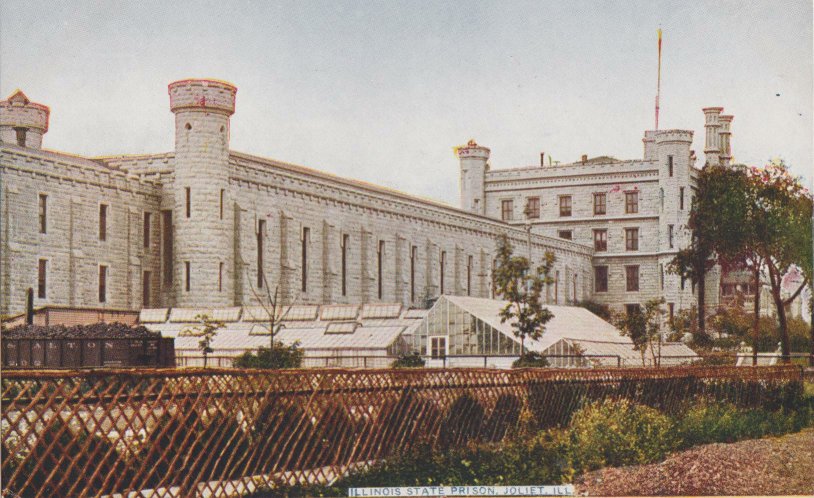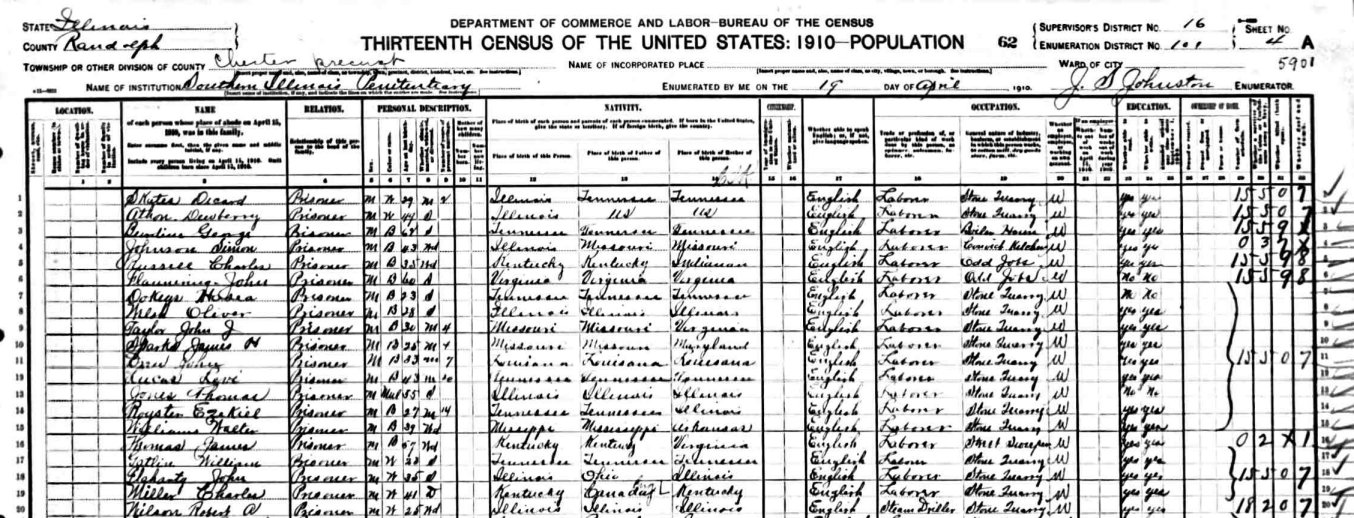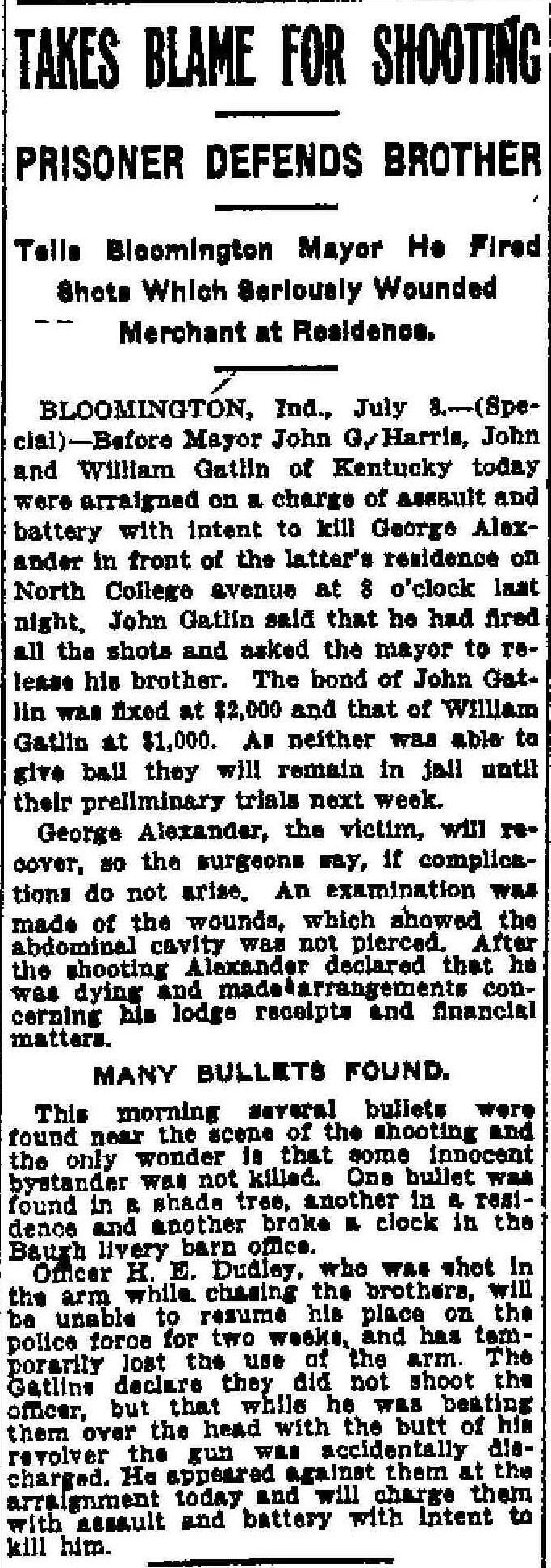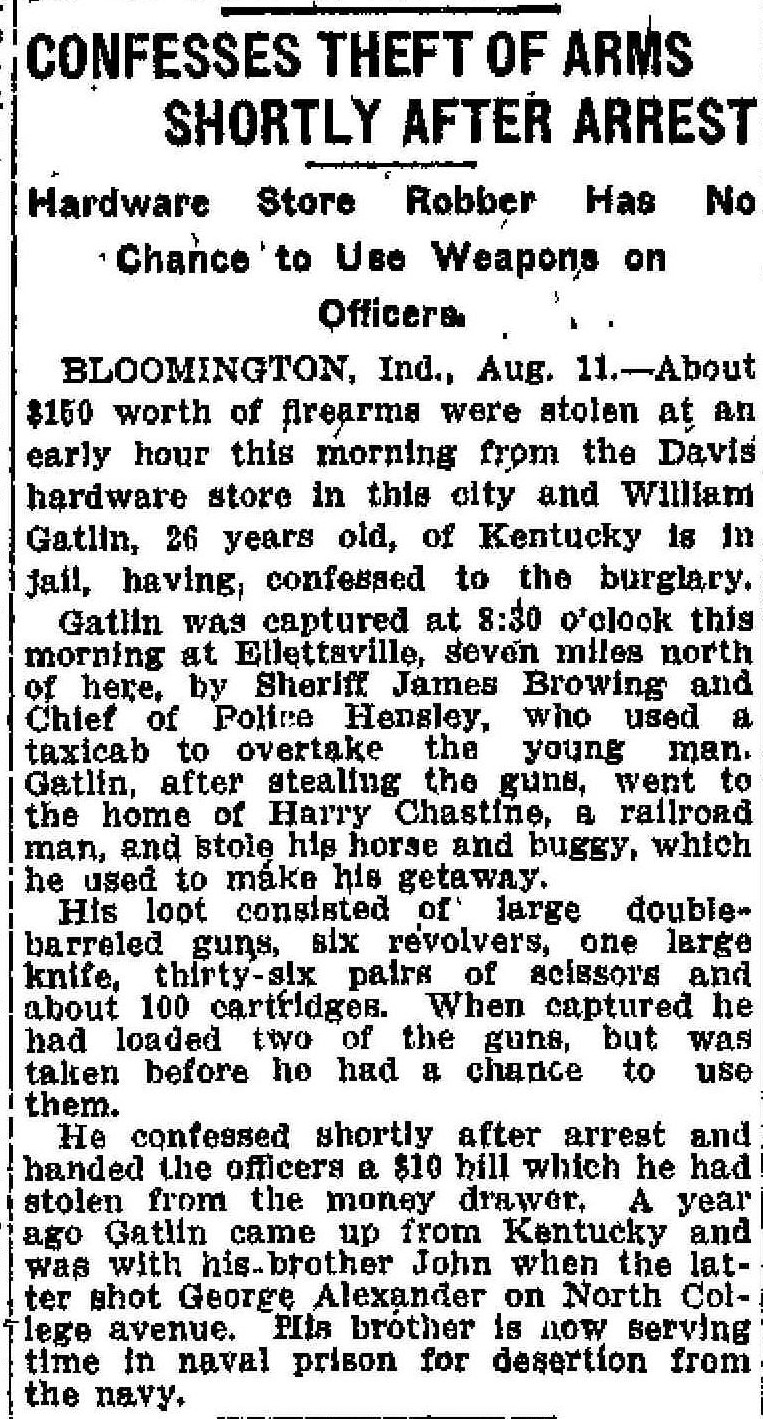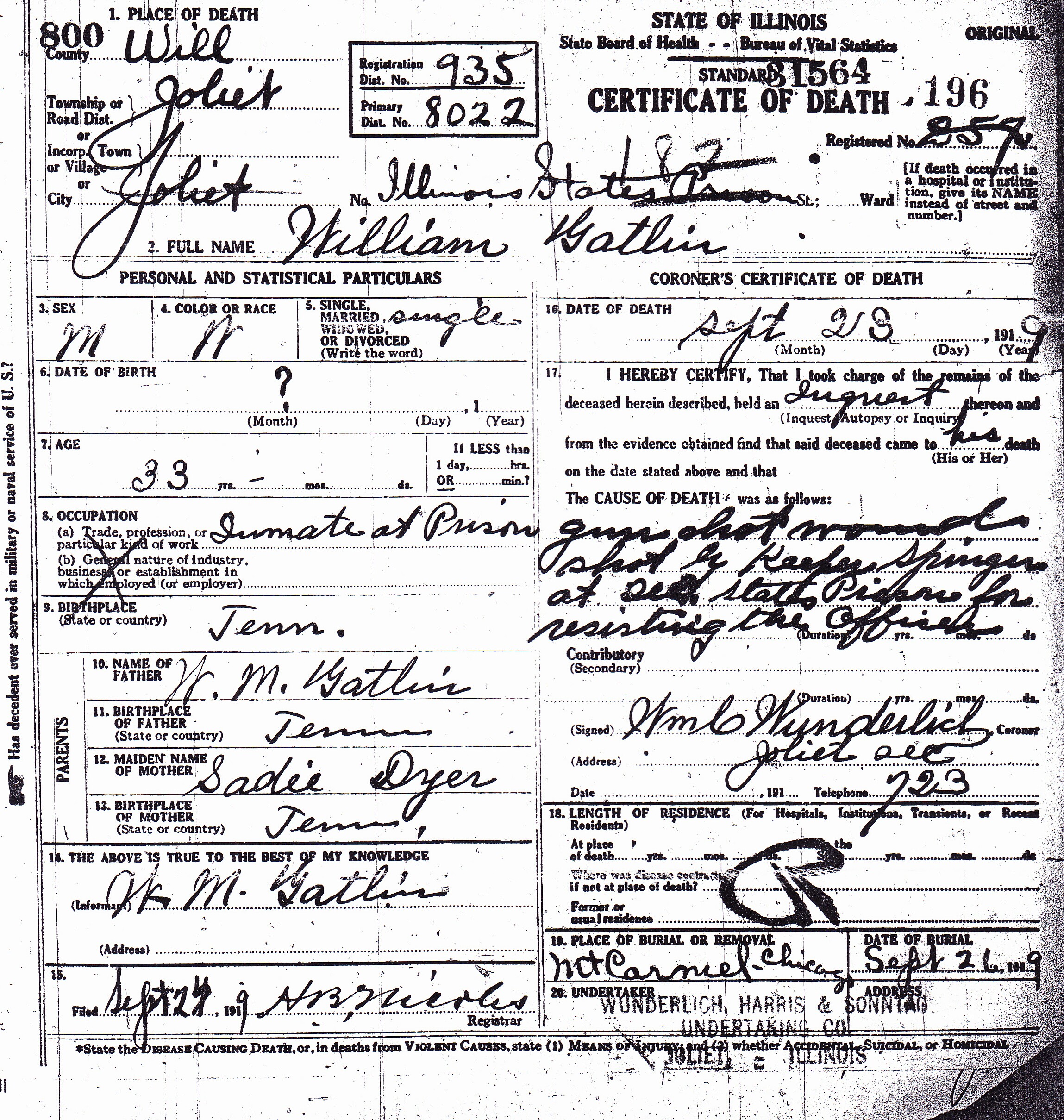Covering genealogy, family history, historical events and places, and anything else related!
Showing posts with label Joliet. Show all posts
Showing posts with label Joliet. Show all posts
Thursday, June 16, 2016
Those Places Thursday: Illinois State Penitentiary
Illinois State Penitentiary was the original name for Joliet Correctional Center in Joliet, Will County, Illinois. It was in existence from 1858 to 2002.
The penitentiary was built with convict labor. In May 1858, thirty-three prisoners arrived from Alton to begin construction. Prison transfers were completed in July 1860.
From the 1870s onward, the penitentiary had work contracts with businesses in the area.
According to the Joliet Prison Post, vol. 1 no. 2 (1914), the inmates at the penitentiary were classified into three grades, which would determine the privileges that they were allowed. Prisoners in the first grade could write letters and have visitors once a week. Prisoners in the second grade were allowed to write and have visitors once every two weeks. Incoming prisoners were placed in the second grade upon arrival, and would be moved to the first grade after thirty days if their conduct was good. The third grade was for "willful offenders against the prison discipline" (p. 57). These prisoners could only write letters and have visitors once every four weeks, and could not go into the yard for recreation.
My great-grandfather's brother William D. Gatlin was sent to the Illinois State Penitentiary on 16 October 1917 to serve a sentence of one to fourteen years for robbery. He died there on 23 September 1919. He was shot by Henry Springer, a guard at the Illinois State Penitentiary, after refusing to obey orders. The incident occurred when William was being taken back to solitary confinement. William must have been in the third grade!
References
Joliet Correctional Center
Joliet Prison Post, Volume 1, Issue 2, 1914
Friday, January 15, 2016
Follow Friday: Explore Chicago Collections
Explore Chicago Collections (http://explore.chicagocollections.org/) can be used to locate archival material from the member 21 institutions of Chicago Collections. Researchers can search for the locations of physical collections that they may want to consult. They can also access digital collections. More than 100,000 images are available.
In addition to searching, it is possible to browse by topics (events, government, daily life, creativity, environments, work), names, cities, and neighborhoods.
I found information on this site which relates to my family history. For example, I found that the Chicago History Museum has the Chicago Typographical Union No. 16 records. My great-grandfather Henry Brown Gatlin was a member of Chicago Typographical Union No. 16. In 1922, he was one of two members to be on the arbitration board, which selected the chairman for wage negotiations. By 1929, he worked as a business agent for the union.The Chicago History Museum also has a Chicago Mercantile Exchange album. My paternal grandfather Henry Cornelius Gatlin was a member of the Chicago Mercantile Exchange, and also served as director and officer. I also found two photos of the Chicago Mercantile Exchange Center. The first and second photos were taken from different angles. There are also photos of the Illinois State Penitentiary at Joliet, Illinois. My great-grandfather's brother William D. Gatlin was there from 16 October 1917 to 23 September 1919, when he was shot after he tried to attack a prison guard.
If you have ancestors who lived in Chicago, this site is worth a look!
In addition to searching, it is possible to browse by topics (events, government, daily life, creativity, environments, work), names, cities, and neighborhoods.
I found information on this site which relates to my family history. For example, I found that the Chicago History Museum has the Chicago Typographical Union No. 16 records. My great-grandfather Henry Brown Gatlin was a member of Chicago Typographical Union No. 16. In 1922, he was one of two members to be on the arbitration board, which selected the chairman for wage negotiations. By 1929, he worked as a business agent for the union.The Chicago History Museum also has a Chicago Mercantile Exchange album. My paternal grandfather Henry Cornelius Gatlin was a member of the Chicago Mercantile Exchange, and also served as director and officer. I also found two photos of the Chicago Mercantile Exchange Center. The first and second photos were taken from different angles. There are also photos of the Illinois State Penitentiary at Joliet, Illinois. My great-grandfather's brother William D. Gatlin was there from 16 October 1917 to 23 September 1919, when he was shot after he tried to attack a prison guard.
If you have ancestors who lived in Chicago, this site is worth a look!
Saturday, June 21, 2014
52 Ancestors: #25 William D. Gatlin, Convicted Felon
Crime ran on both sides of the family of William D. Gatlin. His paternal grandfather William Dow Gatlin (who he probably shared a name with; I suspect that his middle initial D stood for Dow) was tried for an ax murder. His mother's half-brother Tom Cox was sentenced to death for killing a police officer. William D. Gatlin never killed anyone (as far as I know), but he was frequently in trouble with the law.
William was born on 10 December 1886 in Nashville, Tennessee. He was the third child of John William Morton Gatlin and Sarah Claire "Sadie" Dyer. By 1904 he and his older brother Henry (my great-grandfather) were living together in Chicago, Illinois. Henry was working at Hazlitt Printing Company. I am not sure what William was doing, but at some point he got himself into trouble, because he was enumerated in the 1910 United States Census as a prisoner in Southern Illinois Penitentiary in Chester, Randolph County, Illinois. He had been released by 1911, when he and his brother John were in Bloomington, Indiana, where their older sister Mary Florence (Gatlin) Pate lived with her husband Downie Campbell Pate. The brothers spent time in Kentucky before going to Indiana. On 7 July 1911, William and John got into a fight. George Alexander was sitting on his front porch and tried to break up the fight. He went inside and got his gun. One of the brothers fired a revolver at George. George fired back and did not hit the men, but he was shot and seriously injured. Five police officers pursued the Gatlin brothers, and the men shot at each other. John claimed that he was the one that had shot George Alexander and asked that William be released. However, because William had a criminal record, had given a false name when arrested (he said his name was George Gatlin), and got into more trouble throughout his life than John did, I am not sure if John was telling the truth.
On 11 August 1912, William was arrested again. He stole guns, ammunition, a knife, and 36 pairs of scissors from a hardware store in Bloomington, Indiana. He then stole a horse and buggy to escape, and when he was arrested, he handed the police officers a $10 bill that he had taken from the till at the hardware store.
William was free by 5 June 1917 when he registered for the World War I draft in Chicago, Illinois, but on 16 October 1917, he was sent to Joliet Prison. On 22 September 1919, he and another prisoner, George Cechota, attempted to attack a prison guard while they were being taken back to solitary confinement. Another guard, Henry Springer, came over to help, and he shot William. Three other prisoners escaped during the conflict. William died the next day at the penitentiary hospital. He was buried in Mt. Carmel Cemetery in Hillside, Cook County, Illinois.
William was born on 10 December 1886 in Nashville, Tennessee. He was the third child of John William Morton Gatlin and Sarah Claire "Sadie" Dyer. By 1904 he and his older brother Henry (my great-grandfather) were living together in Chicago, Illinois. Henry was working at Hazlitt Printing Company. I am not sure what William was doing, but at some point he got himself into trouble, because he was enumerated in the 1910 United States Census as a prisoner in Southern Illinois Penitentiary in Chester, Randolph County, Illinois. He had been released by 1911, when he and his brother John were in Bloomington, Indiana, where their older sister Mary Florence (Gatlin) Pate lived with her husband Downie Campbell Pate. The brothers spent time in Kentucky before going to Indiana. On 7 July 1911, William and John got into a fight. George Alexander was sitting on his front porch and tried to break up the fight. He went inside and got his gun. One of the brothers fired a revolver at George. George fired back and did not hit the men, but he was shot and seriously injured. Five police officers pursued the Gatlin brothers, and the men shot at each other. John claimed that he was the one that had shot George Alexander and asked that William be released. However, because William had a criminal record, had given a false name when arrested (he said his name was George Gatlin), and got into more trouble throughout his life than John did, I am not sure if John was telling the truth.
On 11 August 1912, William was arrested again. He stole guns, ammunition, a knife, and 36 pairs of scissors from a hardware store in Bloomington, Indiana. He then stole a horse and buggy to escape, and when he was arrested, he handed the police officers a $10 bill that he had taken from the till at the hardware store.
William was free by 5 June 1917 when he registered for the World War I draft in Chicago, Illinois, but on 16 October 1917, he was sent to Joliet Prison. On 22 September 1919, he and another prisoner, George Cechota, attempted to attack a prison guard while they were being taken back to solitary confinement. Another guard, Henry Springer, came over to help, and he shot William. Three other prisoners escaped during the conflict. William died the next day at the penitentiary hospital. He was buried in Mt. Carmel Cemetery in Hillside, Cook County, Illinois.
1910 United States Census, Chester precinct, Randolph County, Illinois, population schedule, enumeration district 101, sheet no. 4A.
Indianapolis Star, 8 July 1911
Indianapolis Star, 9 July 1911
Indianapolis Star, 12 August 1912
Chicago Daily Tribune, 24 September 1919
State of Illinois, State Board of Health, Bureau of Vital Statistics. Death certificate, William Gatlin. 23 September 1919.
Labels:
52 Ancestors,
Black sheep,
Bloomington,
Chicago,
Gatlin,
Illinois,
Indiana,
Joliet,
Nashville,
Tennessee
Subscribe to:
Posts (Atom)

